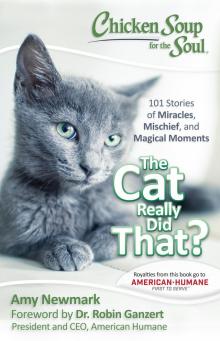- Home
- Amy Newmark
My Very Good, Very Bad Cat Page 9
My Very Good, Very Bad Cat Read online
Page 9
I confess, without shame or apology, that we were putty in the paws of our furry diva. There were no beds soft enough, no toys interesting enough, no food healthy enough for our princess. Laser-focused on everything and anything that made her happy, we began to wonder if she might benefit from some companionship during the lonely hours we were away at work. I must confess there was another reason for considering companionship for her. It had to do with the discovery of an antique glass plate (an heirloom given to me by my mother-in-law), reduced to a pile of glittery dust on the tiles of the fireplace hearth.
We chose a long-haired, coal-black, green-eyed boy with the perfect, easygoing temperament needed to deal with the feisty Miss P and then we crossed our fingers and held our breath when they first met. Miss P sashayed toward the kitten, sniffed his coat, stared for a second, turned her back, and waltzed away, flicking her tail and shooting him a disdainful look. I swear I could hear her saying, “Get out of my way, Buster. You’d better behave yourself, Buster. Just remember who’s in charge here, Buster!” We named him Buster.
Miss P and Buster settled into a harmonious existence. Their relationship was drama-free; she let him know she was the queen, and he acknowledged her superiority and sovereignty.
When Miss P reached her eighth birthday, we began another kitten search. We filled out two pages of forms for the rescue organization and had our home checked out by the kitten foster mother. Finally, deemed “kitten-worthy,” we went to pick up our delightful female Lilac Point. As we moved toward the cat carrier to secure our new kitten, the “foster cat lady” picked up a little male, shoved him toward us and exclaimed, “These two are brother and sister and best friends. I simply couldn’t separate them.” This information might have been helpful earlier, but we fell for his crossed eyes and sweet face and drove home with two new companions for Miss P and Buster to meet.
The two “best friends,” Tucker and Jasmine, proved to be anything but best friends. To this day, they tolerate each other, but exhibit no desire to spend quality time together. Note to self: Don’t always believe everything the foster cat lady tells you.
Over the years, our feline family has become an important part of our lives. When I’m sick, a cat is always ready to cuddle the “patient” to sleep. When I cry, a furry, purry body presses in close, sometimes extending a paw (claws pulled in) to gently tap my face, letting me know everything will be okay (or to remind me to get up and feed them dinner). They even do us the honor of “singing the song of their people” in the wee hours of the morning.
I am childless by circumstance, not by choice. I used to avoid Mother’s Day celebrations and felt empty and awkward at baby showers. In the course of emptying litter boxes, searching for delightful and delicious treats, and educating myself on the benefits of organic catnip, the empty “mother’s hole” in my heart has healed in a way I’d never expected.
My feline family has taught me three valuable life lessons. First, happiness comes when I focus on what I have, rather than what is missing in my life. Second, I must never diminish the love in my life because it doesn’t look exactly like the love in the lives of others. The third lesson was this: Family isn’t always comprised of blood relations, nor is it necessarily comprised of humans.
People can be judgmental: “Four cats? No kids?” “Really, you seem to expend too much energy, love and money on those cats.” “I understand you love your pets, but they are animals, not children!”
I let them prattle on. They don’t know my story; they haven’t walked beside me through my painful, childless journey. They see cats; I see healers of my heart.
“Crazy Cat Lady” is a title I wear proudly. The mockers don’t understand that it’s precisely because of my cats that I have not gone crazy. I am the recipient of the unconditional love of fantastic little beings who look to me to care for them, protect them and return their love in abundance.
The felines I share my life with today continue the journey of healing that began twenty years ago, the day I looked into the blue eyes of a special kitten. If that makes me a “crazy cat lady,” then call me crazy.
~Anita Aurit
Knee Cat
Fun fact: There’s an old saying among veterinarians: “If you put a cat and a bunch of broken bones in the same room, the bones will heal.”
When I came home from the hospital after my knee-replacement surgery a few years ago, a black cat was lounging in the spring sunshine in my front yard. As my sister pulled her car into the driveway, she jokingly asked, “Oh, you have a new cat?”
“No,” I grumbled. “I have a new knee. The last thing I need is a new cat.”
My previous cat, which had lived with me for twelve years, had passed away a little over a year earlier. Now that I would be creeping around slowly with a walker while recovering for the next few weeks, I had decided it was not a good time to adopt a new pet.
However, this cat was not aware of my decision.
I had visits from the nursing service, my sister, my mother and my neighbor, who snuck me doughnuts and frozen pizzas to offset the fresh fruit from my sister and the vegetable casseroles from my mother. Meanwhile, that cat continued to hang around.
“Your black cat is beautiful,” said the visiting nurse.
“I see your new cat is still here,” mentioned my sister.
“Is that your cat out by the garage?” asked my neighbor.
“That is not my cat,” I informed all of them.
But, just like them, I did see the cat every day, either wandering around the garden or napping on the sidewalk in the sunshine. It didn’t seem to have a home, so in the mornings, I put out a bowl of tuna on the front porch. I couldn’t let the cat go hungry.
My knee recovery continued, painfully and slowly. My mood didn’t perk up either. I was bored and cranky.
“The problem is you’re not walking enough,” said the visiting nurse. “The weather is good. You should get outside in the yard every day.”
“What for?” I grumbled. “I can’t garden. I can’t mow. All I can do is shuffle around with this walker.”
“That’s okay,” replied the nurse. “The exercise will do you good.”
I was totally unmotivated to get outside. I continued to sit in my chair, watch TV and complain that my knee hurt.
A couple of days later, I found the tuna in the cat’s bowl had not been eaten. And it remained untouched for the next three days.
“I don’t see that beautiful cat around anymore,” said the visiting nurse.
“Hey, what happened to your new cat?” asked my sister.
“What did you do to get rid of that black cat?” said my neighbor.
I couldn’t believe that cat had just disappeared, so hesitantly, I wrangled my feet into my sneakers, gripped my walker and struggled out the door. My steps were small and shaky at first, but I made it out to the patio where I found the cat reclining under the picnic table.
“Aren’t you hungry?” I asked.
The cat meowed loudly and followed me back to the porch where it quickly gobbled up the tuna.
But the next day, the cat didn’t show up again, so once more I got myself together and headed outside. This time I wandered a bit farther and found the cat sitting under the hydrangea bush.
“What’s the matter?” I asked. “Your food is on the porch.”
The cat followed me back and ate his meal again.
This routine continued for the next week. I would find the cat by the garden shed, sitting in the wheelbarrow or napping under the crabapple tree, but he wouldn’t come to eat until I discovered where he was concealed.
It was crazy, but the cat seemed intent on making me follow the nurse’s instruction to do more walking. Finally, I told others about the situation.
“Hey,” replied the visiting nurse. “Anything that gets you up and moving works for me.”
“There is nothing like a rousing game of ‘find the kitty’ to make you feel better,” my sister assured me.
“Well,” commented my neighbor. “I guess he must be a knee cat.”
So, for the next month, Knee Cat, as he came to be known, continued assisting me with my rehabilitation by waiting for me to find him somewhere in the yard and then coming over to eat his food. Every day, I got better, stronger and less cranky.
Finally, I recovered fully and was able to go back to work. Knee Cat and I no longer had time for our game of hide-and-seek, so the cat started coming to the porch every morning to eat like he had in the beginning.
Summer passed, autumn blustered in, and before the first frost, I convinced Knee Cat to move into the house with me.
Sometimes, I still have to hunt to find him, but now Knee Cat sleeps in the closet, curls up on the bed or sits on the back porch; regardless, he never misses a meal.
And thanks to my unusual encouragement from Knee Cat, my knee is working fine, too.
~David Hull
Reprinted by permission of Bruce Robinson
Comfort of a King
Fun fact: A tuxedo cat named Simon was given a medal for protecting the soldiers’ food from mice on board a ship in the South Pacific during World War II.
One of our cats, KC, was the undisputed king of the neighborhood. He would make the rounds of the neighborhood and people would invite him in and pay tribute in the form of treats and lots of petting.
Our next-door neighbors, the Benders, didn’t know what to make of our animal-loving household. Mr. and Mrs. B and their two children lived a pet-free existence in their tidy ranch home. Although Mrs. B and the kids loved our menagerie, Mr. Bender didn’t like cats.
This didn’t deter KC, who always started his travels outside the Benders’ kitchen door. Even though they seldom gave him a treat, he remained hopeful. He would sit on their stoop, emitting the occasional plaintive “Meow.” If the Benders were around, they would pet him, but KC couldn’t understand why they wouldn’t let him inside.
Then Mr. Bender was diagnosed with an aggressive cancer, and KC didn’t even get his petting from the Benders. Caring for Mr. B was all they could handle. Undeterred, KC continued to stop outside their kitchen door, tilting his head and waiting patiently before he moved on to more receptive neighbors.
A few months later, KC disappeared one night. I was worried. The old fellow wandered, but he was usually home by dark. I stepped into the yard calling, “KC, KC!”
The light over the Benders’ kitchen door came on, and Mrs. B, finger to her lips, gestured for me to come in. She took me to her husband’s sick room. The tall strong man I’d known had wasted away. He was sleeping, and it took me a moment to realize what I was seeing. Mr. B’s withered hand was resting on KC, who was tucked close to his side. The old tom was purring like a motorboat.
“I don’t know how he got in the house,” Mrs. Bender whispered, “but he seems to be a comfort. This is the best Mr. B has slept in weeks.” She reached down and ruffled KC’s ears. “Do you mind if he stays the night?”
KC quit doing his neighborhood rounds. He stayed with Mr. Bender whenever he could. He would lie by the man’s side, purring to make his presence known. He seemed to be sure, in the way cats have, that Mr. Bender needed the comfort only a feline could give.
A few months later, Mr. B passed away. Thereafter, whenever KC stopped by the Bender household, he was always invited in to continue the important job of comforting the family.
~Leslie Gulvas
Missionary Cat
Fun fact: Cats rub against people they like to mark them as part of their “gang.”
Stripes was a silver Tabby with no remarkable features except one: the tip of his nose was half-white and half-brown. Despite his rather ordinary appearance, we very quickly discovered that Stripes had a unique talent: He was able to win the affection of practically every person he encountered. We often had meetings, home-school get-togethers and Bible studies in our house, and Stripes greeted and saw to the comfort of every guest. Even cat-haters would succumb to his gentle purr and docile temperament.
Stripes patiently endured being dressed up in various outfits, carried in numerous objects, and being the accomplice in many prankish activities, while seeming to love every minute of it. He was a people cat. In the seventeen years we had him, I never heard him hiss or strike at anything other than another male cat that dared to step on our property. He would chase squirrels and birds, but would never actually catch them.
Another talent Stripes had was exploring. This is not unusual for a cat, but Stripes excelled in the art. He explored the interior of our cars and took many unwitting trips. He would follow us on walks, and people would say, “Is that your cat?” Then we would hear stories about his visits. Our neighborhood became affectionately known as “Stripesdom” to his regulars.
Stripes made his rounds twice a day — in the morning and in the evening. But after about five years, he suddenly had to be let out by 7:15 every morning, and he would meow and be uncharacteristically obnoxious until we did. Once the door was open, he would bolt from the house. Other times of the day, he was more flexible, but not in the morning. We chalked it up to his advancing years and becoming “set” in his ways. After about two years of this, he suddenly stopped. Finally, we could sleep in on Saturdays.
About six months later, I was working in the yard when a passerby saw Stripes sunning himself and asked, “Is that your cat?” I said yes, and she went on to tell me an amazing story about our beloved Stripes.
The lady lived about a block-and-a-half away from us. An elderly couple lived across the street from her. They had had a long and full life together traveling the globe and pursuing shared interests. One unfortunate evening, the man died. After a few weeks, the lady went to check on the widow. She said that she was doing all right, but the hardest part of the adjustment for her had been breakfast. Throughout their married life, no matter what their schedule, they always had coffee and read the paper together first thing in the morning. This was when she missed her husband the most. Yet, a couple of days after her husband died, this cat showed up in her breakfast nook window wanting to come in. She let him in and gave him some milk. He drank it, rubbed against her, began purring, and then curled up on her husband’s chair next to her. She stroked his fur while she read the paper. As soon as she put down the paper and stood up, he got down and went to the door to be let out.
Stripes visited the widow practically every day at 7:30 in the morning. The widow had come to love him and wait expectantly for him, giving him treats and milk with each visit. She was sure God had sent an angel in the form of a cat to comfort her in her darkest moments.
When I asked how the widow was, the lady told me that she had died about six months earlier. She had seen Stripes visit for a day or two afterwards, then he didn’t come anymore.
Another time, a woman on a playground told me how Stripes had come up to her daughter, who was sitting forlornly on a swing the day they lost a family pet. He had rubbed against her and then stood up, putting his paws on her legs and rubbing his head against her arm. Her daughter held and hugged him for quite a while. That little visit of his calmed the girl and gave her hope that maybe she could love another pet one day.
After we had Stripes almost fifteen years, we moved to another state. An elderly woman lived across the street from us. Stripes visited her daily, this time in the afternoon. She said she enjoyed how he would jump up in her lap and lie there for a while. Stripes was getting older himself at this point. About a year later, the arthritis in his hips meant he could no longer jump up, but he would still visit and lie near her feet so she could pet him.
Stripes was always affectionate with our family. But whenever anyone in the family was sick or sad, Stripes would lie by that person’s side for extended periods of time, lick a hand or head, and offer his fur for petting, frequently giving up some of his outside patrols. It seemed that Stripes felt it was his mission in life to seek out and comfort people who were hurting. He definitely had a sense for detecting people who needed
emotional encouragement. Perhaps the widow had been right. Maybe there really was an angel living inside Stripes.
~Ann Joseph
Lion’s Gift
Fun fact: The Quakers first began to use animal therapy in treating the mentally ill in the 1790s.
She appeared in our back yard on an otherwise ordinary day. Sitting in the grass, which complemented her autumn coloring, she stared at us with the utter surety that very few creatures possess as cats do — a kind of dignified defiance.
She was beautiful, with chocolate-brown stripes, green eyes, and a fluffy white ascot at her throat. My sister, who knows cats, decided that she was a Tabby mix, possibly with some Persian thrown in, which explained her white boots and tail-tip. She named her Lion for the way she stalked through the grass.
Why she had chosen us can only be explained by that lovely, mysterious force that is known by many names: fate, kismet, destiny, serendipity, providence, luck. My pragmatic mother said that Lion came because the family that had lived in our house previously had fed her, so she thought of our back yard as her watering hole. Personally, I think she came to us because she knew we needed each other.
Lion usually camped out in our yard, but on bitterly cold or rainy nights she came inside. She hated getting wet. She always looked disgruntled on those nights: soaking wet, ears flattened, whiskers dripping. She would purr while I dried her off with a towel.
Although she loved a cozy bed or chair, she could never bear to stay inside for more than a day. She possessed a restlessness, an innate fear of being hemmed in. Being a stray, and semi-feral to boot, she never became a docile housecat. She always possessed a bit of an edge.
One day, while I was vacationing in Florida, my aunt, who was pet-sitting Lion, called me in a panic. Lion was making awful noises, having some kind of a fit. She was sure that Lion was going to die.

 Chicken Soup for the Soul
Chicken Soup for the Soul The Joy of Less
The Joy of Less Hope & Miracles
Hope & Miracles The Cat Really Did That?: 101 Stories of Miracles, Mischief and Magical Moments
The Cat Really Did That?: 101 Stories of Miracles, Mischief and Magical Moments The Joy of Christmas
The Joy of Christmas My Very Good, Very Bad Dog
My Very Good, Very Bad Dog My Very Good, Very Bad Cat
My Very Good, Very Bad Cat